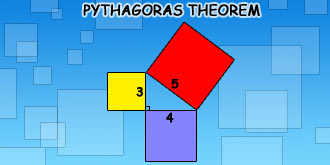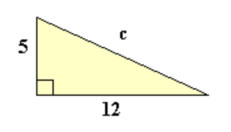Pythagoras Theorem
The Pythagoras Theorem allows us to find the length of the third side on a right angle triangle if we know the other two lengths.
Don’t forget:
It only works on right angled triangles.
You need to know at least two other lengths.
The formal definition is: In a right angled triangle the sum of the square of the hypotenuse is equal to the sum of the squares of the other two sides.
Algebraically a2 + b2 = c2
('a' squared plus 'b' squared equals 'c' squared)

c is always the hypotenuse.
Therefore 32 + 42 = 52
(three squared plus four squared equals five squared)
Which goes to 9 + 16 = 25
This can be used to find the length of an unknown side
|

a2 + b2 = c2
52 + 122 = c2
25 + 144 = 169
c2 = 169
c = √169 (square root of 169)
c = 13 |
|
Check that you understand what these words mean in this document
Right angled triangle: the geometrical shape of three sides whose one angle is 90 degrees.
Hypotenuse: the side opposite the right angle.
For further information visit:
Proof of Pythagoras Theorem
|

